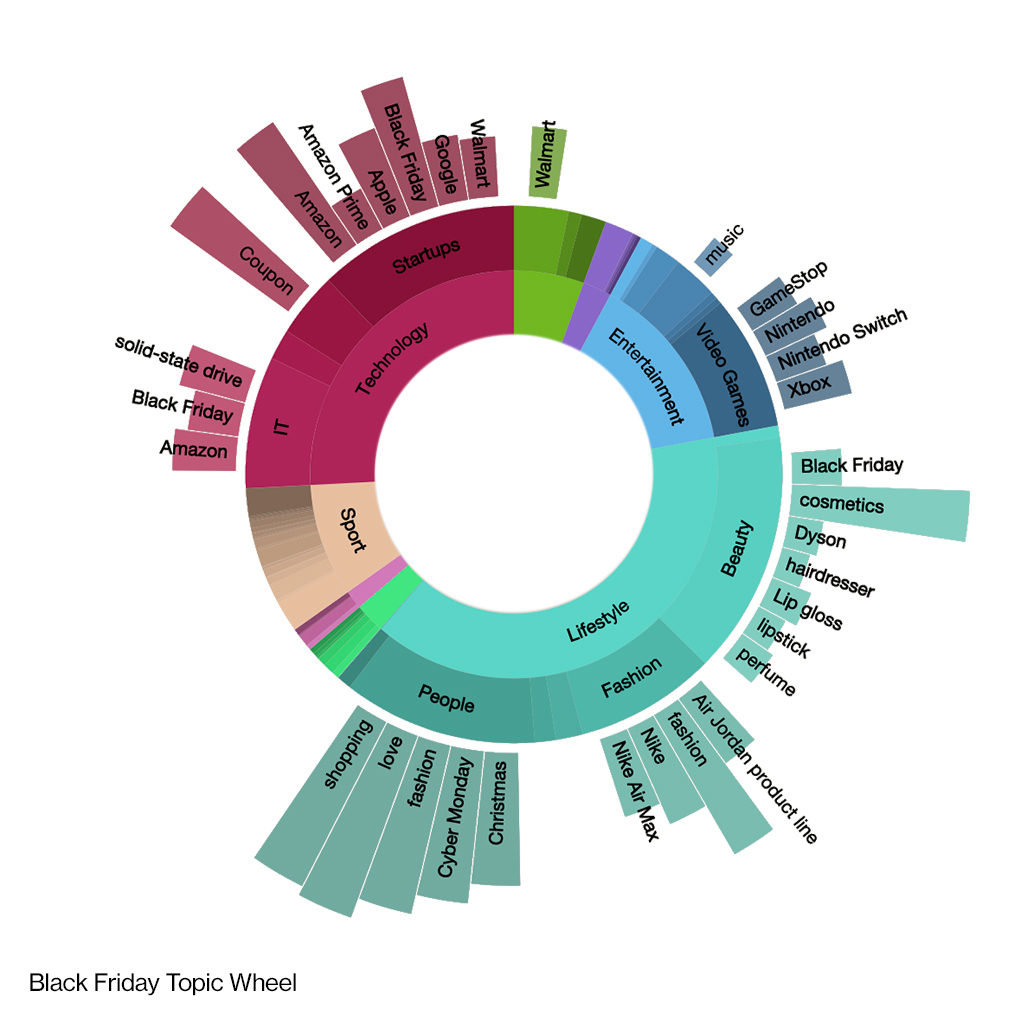Ahead of Black Friday, we used social listening from previous years to help us predict emerging Black Friday themes for 2021. We used query writing and in this case, Radarly, to pick out success factors and key learnings from 2020. This is achieved through looking at the keywords, topic wheel and sentiment breakdown to find the trends/topics which are most mentioned and liked.
Looking at the previous year and the number of mentions per key topic; Technology, Beauty, Fashion, and Entertainment dominated Black Friday’s social conversation with brands including Amazon, Walmart, Apple, and Nike being most mentioned. Etsy was also an interesting brand in the top 10 due to its emphasis on promoting small businesses, which was seen as a key trend in 2020.

Check out our findings on emerging topics, and how brands drive content engagement in a saturated media landscape.
Shop local and support small businesses
Unsurprisingly, the majority of the conversation surrounding Black Friday was around big sales and discounts. But an emerging topic about shopping local also got its share of interest as mentions increased by 72% from 2019. An uprising group of consumers is more willing to spend on brands striving for positive changes, giving back to social causes and supporting small businesses, indicating a shift away from excessive consumption to sustainable shopping. COVID-19 likely acted as a catalyst for a more considerate approach to retail processes.
Sustainability and mindfulness
Some campaigns rejected Black Friday and instead helped consumers make better choices through gift guides or donating profits to charity. Brands encouraged their consumers to buy consciously instead of offering site-wide sales. Examples of these anti-Black Friday campaigns are Blue Friday, Green Friday, Haglofs Restored Campaign, and Indie Week.
Blue Friday is an anti-Black Friday campaign promoted by Sea Shepherd to get consumers to shop sustainably for the ocean. They created a sustainable holiday gift guide to help make sustainable shopping easier for consumers.
View this post on Instagram
Green Friday encourages consumers to think about what they already have, not rush to shop and opt for sustainable items if they really need something. Brands have tailored their campaigns to Green Friday by planting trees with every order or by accepting donations for charities.
View this post on Instagram
For their anti-Black Friday campaign, Haglofs Restored sold repaired and restored gear. They didn’t offer discounts and you couldn’t purchase from them on Black Friday. Instead, they sold seven restored items on their Instagram stories. Feedback from this campaign was very positive with people praising the “powerful message” and the “brilliant idea”.
View this post on Instagram
Indie week, supported by ‘Just a card’, focussed on raising awareness for small businesses. It’s about encouraging consumers to support local businesses by giving them a shout-out and shopping local.
Driving Content Engagement
While Black Friday continues to be one of the busiest retail periods of the year, there are ways that you can stand out.
A survey from Matter found that only 38% of consumers trust brands and that influencers are continuing to drive conversation and impact consumer behaviour during the pandemic. Influencer videos are well perceived by users with users’ comments including how authentic the video is and how it is the reason they spent so much, likewise with exclusive promo codes.
Secondly, content creation is key. Carousel formats are emerging and gaining higher engagements; the format works well as it gets the sales messages/CTA across quickly. Memes are mainly used by smaller businesses as a creative approach to stay topical and culturally relevant, but even bigger brands can use memes to be more relatable.
Finally, utilise time-sensitive messaging. Limited-time offers that highlight a sense of urgency such as ‘final day’ and ‘ends tonight’ could drive customers’ interest and time sensitivity to react.
What else have you seen? To find out more about our analysis, email our Junior Insights Analyst Ariana at ariana.biscardi@sharecreative.com and click here to find out more about our Intelligence team.
